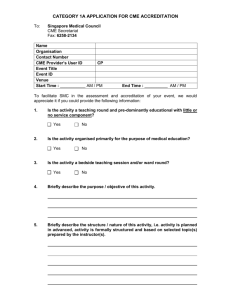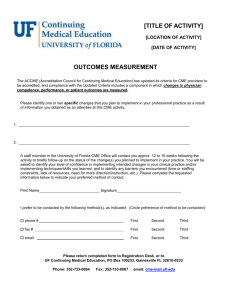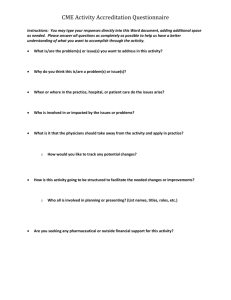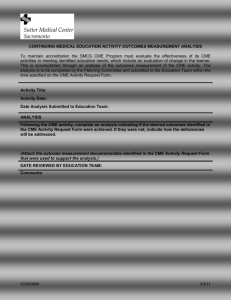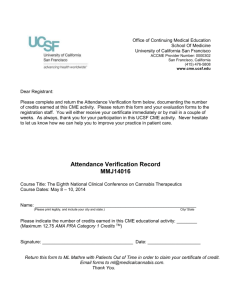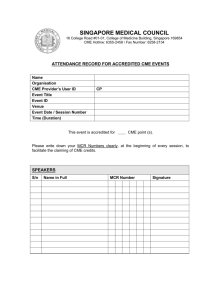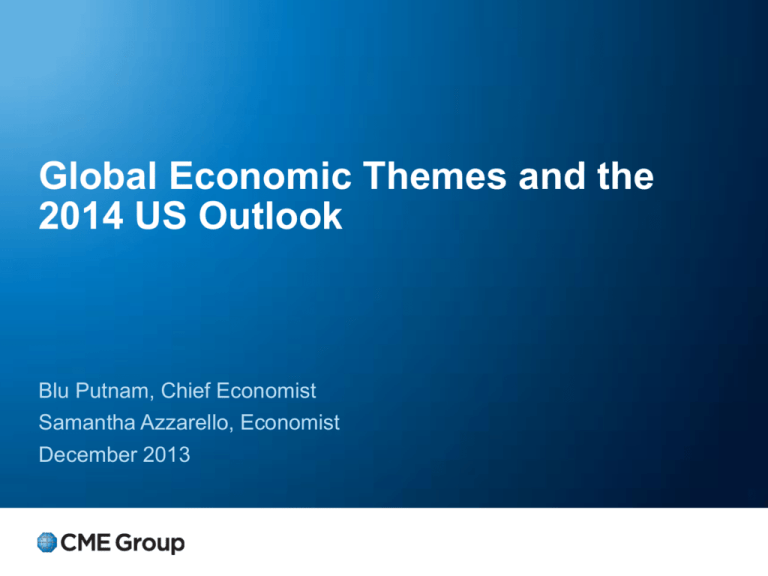
Global Economic Themes and the
2014 US Outlook
Blu Putnam, Chief Economist
Samantha Azzarello, Economist
December 2013
Disclaimer
Neither futures trading nor swaps trading are suitable for all investors, and each involves the risk of loss. Swaps trading should only
be undertaken by investors who are Eligible Contract Participants (ECPs) within the meaning of Section 1a(18) of the Commodity
Exchange Act. Futures and swaps each are leveraged investments and, because only a percentage of a contract’s value is required
to trade, it is possible to lose more than the amount of money deposited for either a futures or swaps position. Therefore, traders
should only use funds that they can afford to lose without affecting their lifestyles and only a portion of those funds should be devoted
to any one trade because traders cannot expect to profit on every trade. All examples discussed are hypothetical situations, used for
explanation purposes only, and should not be considered investment advice or the results of actual market experience.
Any research views expressed are those of the individual author and do not necessarily represent the views of the CME Group or its
affiliates.
CME Group is a trademark of CME Group Inc. The Globe Logo, CME, Globex and Chicago Mercantile Exchange are trademarks of
Chicago Mercantile Exchange Inc. CBOT and the Chicago Board of Trade are trademarks of the Board of Trade of the City of
Chicago, Inc. NYMEX, New York Mercantile Exchange and ClearPort are registered trademarks of New York Mercantile Exchange,
Inc. COMEX is a trademark of Commodity Exchange, Inc. KCBOT, KCBT and Kansas City Board of Trade are trademarks of The
Board of Trade of Kansas City, Missouri, Inc. All other trademarks are the property of their respective owners.
The information within this presentation has been compiled by CME Group for general purposes only. CME Group assumes no
responsibility for any errors or omissions. Additionally, all examples in this presentation are hypothetical situations, used for
explanation purposes only, and should not be considered investment advice or the results of actual market experience.
All matters pertaining to rules and specifications herein are made subject to and are superseded by official CME, CBOT, NYMEX,
COMEX and KCBT rules. Current rules should be consulted in all cases concerning contract specifications.
Copyright © 2013 CME Group. All rights reserved.
© 2013 CME Group. All rights reserved.
2
Global Context
© 2013 CME Group. All rights reserved.
3
Outline
• Global Context – In the Rear View Mirror
- At the end of 2012, among other things, we were worrying
about:
• the US going off the fiscal cliff,
• the sovereign debt crisis-induced austerity and
recession in Europe,
• Japan’s new stimulus policies, and
• the potential for a hard landing in China.
- As it happened,
• the US avoided the cliff,
• Europe appears to have touched bottom even if not yet
growing,
• the Japanese yen weakened for a few months then
stabilized, and
• China managed its deceleration and transition to new
leadership very well.
© 2013 CME Group. All rights reserved.
4
Outline
• Global Context – Going Forward
- For 2014, our concerns have shifted:
• For Europe to grow, the banking system needs more
capital and EU-wide reforms. How this happens in the
midst of a leadership vacuum is not so clear.
• The UK is doing better than the continent and may even
contemplate raising rates in 2014 if improved economic
trends take hold, possibly the lifting the pound relative
to the euro.
• Japan is likely to hit a major bump in the road with the
national sales tax increase coming in April.
• China appears to be choosing to accelerate its reforms
and increase the pace of economic liberalization with
more market-based initiatives.
• Global energy markets are watching the course of
diplomacy with Iran and trying to understand the longerterm implications of rising supply from North America.
© 2013 CME Group. All rights reserved.
5
Euro-Zone & UK
Real GDP Growth:
UK Compared to the Euro-Zone Countries
Annual Average Percentage Change
6%
4%
UK
2%
Projected
0%
-2%
Euro-Zone
-4%
-6%
-8%
2005
2007
2009
2011
2013
2015
Source: Bloomberg Professional.
© 2013 CME Group. All rights reserved.
6
Japan
Japan: Real GDP
10%
Real GDP, Quarter over Qaurter
at Annualized Rate
8%
6%
4%
Projected
2%
0%
-2%
-4%
-6%
Sales Tax Increase
Arrives in April 2014
-8%
-10%
2010
2011
2012
2013
2014
Source: Bloomberg Professional
2015
© 2013 CME Group. All rights reserved.
7
Emerging Markets – Role of Global Influences
Emerging market economies, led by the large BRIC nations are seeing their
economic growth decelerate from the superior pace which they had
become accustomed in the previous decade. We have noted two separate
reasons.
First, less than robust growth in the older, industrial countries (i.e., Japan,
Europe, the US) since the 2008 financial panic is providing a significant
drag on the ability of emerging market countries to grow their exports.
Second, the rising tide of the strong growth period (2003-2010) lifted all
boats, but the ebbing tide has exposed serious, although quite different,
structural challenges in each of the BRIC nations. In addition, to slowing
economic growth, the structural issues have raised risk flags for global
investors, and emerging market currencies and equities came under
intense pressure in 2013.
© 2013 CME Group. All rights reserved.
8
BRIC Nations
© 2013 CME Group. All rights reserved.
9
Emerging Market Currencies
© 2013 CME Group. All rights reserved.
10
Structural Challenges faced by the BRIC Nations
Brazil
The expansion of the middle class, taking millions out of poverty,
has also come with raised expectations of the services they look
to the government to provide – from education to public safety to
water and electricity. Brazil is behind the curve on many of these
services. The juxtaposition of deficiencies in basic services with
substantial government spending on the upcoming World Cup
and Olympics has resulted in increased political turmoil.
© 2013 CME Group. All rights reserved.
11
Brazil
© 2013 CME Group. All rights reserved.
12
Structural Challenges faced by the BRIC Nations
Russia
Essentially an energy-exporting syndicate, Russian government
revenues are closely tied to the fortunes of the global oil and gas
industries. While the expansion of global oil and gas production,
especially from North America, has yet to lower world oil prices,
Russia is highly vulnerable should prices slide. To assist in
diversifying the economy, Russia has entered the World Trade
Organization (WTO), but no meaningful increase in foreign direct
investment has materialized given serious concerns about
property rights and enforcement of contracts in the country.
© 2013 CME Group. All rights reserved.
13
Russia
© 2013 CME Group. All rights reserved.
14
Structural Challenges faced by the BRIC Nations
India
India subsidizes both petroleum and food to the tune of several
percentage points of GDP annually. These subsidies effectively
lock in a current account deficit. India is also a leading country in
gold importation. There is little progress on reducing subsidies,
but India has raised import tariffs on gold to reduce demand.
Current account deficits are difficult to fund given India’s
relatively restrictive capital controls, which work to limit foreign
direct investment. This means that short-term capital flows to
offset the current account deficit often are attracted only at the
price of a depreciating currency.
© 2013 CME Group. All rights reserved.
15
India
© 2013 CME Group. All rights reserved.
16
Structural Challenges faced by the BRIC Nations
China
China’s new leadership has recognized that the state-run infrastructure spending of the last 30 years has now entered a period
of diminishing returns. A transition is underway to shift toward a
more domestic-demand growth model. That transition is only
likely to go well if greater price flexibility is provided to
consumers and companies to improve the price discovery
process and allow for more efficient allocation of resources and
capital. Moreover, the price discovery process will be badly
flawed if all segments of the economy are not allowed to
participate in domestic markets that have meaningful linkages to
international markets. The new leadership apparently has come
to grips with the need to trade away some powers of control to
obtain the promised benefits. A faster pace of renminbi
normalization and an opening of markets to more international
linkages now seems increasingly likely.
© 2013 CME Group. All rights reserved.
17
China
© 2013 CME Group. All rights reserved.
18
China
© 2013 CME Group. All rights reserved.
19
US Economic Outlook
© 2013 CME Group. All rights reserved.
20
US Economic Outlook
• Financial Recession’s Lagging Impacts:
- Finally Leaving Deleveraging Behind
• Fiscal and Regulatory Policy:
- Drag diminishing
• Monetary Policy:
- QE Ends, Zero Target Federal Funds Rate Stays, and
Lagged Effects Start to Kick-In
• Energy Boom:
- Key Policy Decisions Loom, yet Overall Impact Remains
Highly Positive
• US 2014 Economics Projections
- US Real GDP for 2014 = 3.5%
- US Core Inflation by December 2014 = 1.7%
- Target Federal Funds Rate by December 2014 = 0.25%
© 2013 CME Group. All rights reserved.
21
US Financial Health
Leaving the Deleveraging Phase Behind
- Recovery from financial disasters is generally more difficult and
takes longer than a cyclical correction.
- US corporations generally had restored profitability by 2011.
- US consumers mostly completed their deleveraging by 2012.
- State and local governments, for the most part, did not get their
operating expenses lined up with their revenues until 2013.
- From a financial health perspective, the US enters 2014 in the
best shape since the recovery began.
- The US economy is position to see further job growth and an
unemployment rate below 6.5% in the second half of 2014.
© 2013 CME Group. All rights reserved.
22
US Corporate Profits
US Corporate Profits After Tax with Inventory
Valuation Adjustment and Capital
Consumption Adjustment (GDP Basis)
Trillions of US Dollars
$2
$1
Corporate Profits
Rebounded
Relatively Quickly
$0
1997
1999
2001
2003
2005
2007
2009
2011
2013
Source: St. Louis Federal Reserve FRED Database (CPATAX)
© 2013 CME Group. All rights reserved.
23
US Labor Market
US Private Sector Jobs
1000s of Private Sector Jobs
118,000
115,000
112,000
109,000
Private sector job
growth has been
about as strong as
the last economic
recovery -- starting
from a lower base.
106,000
103,000
100,000
2003
2005
2007
2009
2011
2013
2015
Source: Federal Reserve Bank of St. Louis FRED Database (USPRIV)
© 2013 CME Group. All rights reserved.
24
US Consumer Credit
Total Consumer Credit Owned and Securitized
Trillions of US Dollars
$4
$3
$2
Consumer is no
longer deleveraging
$1
$0
1997
1999
2001
2003
2005
2007
2009
2011
2013
Source: St. Louis Federal Reserve FRED Database (TOTALSL)
© 2013 CME Group. All rights reserved.
25
US Labor Market
US Federal, State, and Local Government Jobs
1000s of Government Jobs
23,500
23,000
Census Workers (2010)
22,500
22,000
QE was never going to help
state and local governments get
their budgets in order -- jobs
needed to be adjusted to
revenues and they finally have.
21,500
21,000
20,500
2003
2005
2007
2009
2011
2013
Source: Federal Reserve Bank of St. Louis FRED Database (USGOVT)
© 2013 CME Group. All rights reserved.
26
US Labor Market
Percent Unemployed in Civilian Labor Force
US Civilian Unemployment Rate
13.00%
9.75%
6.50%
3.25%
0.00%
The Fed first referenced a 6.5% rate threshold in Dec-2012.
In Feb-2013 we issued a projection that we would reach the
6.5% rate in the summer of 2014. We are still on track.
Source: St. Louis Federal Reserve Bank "Fred" Database (UNRATE)
© 2013 CME Group. All rights reserved.
27
US Labor Market
Net New US Non-Farm Payroll Jobs Per Month
350
1000s per Month
300
250
200
150
100
Monthly jobs data are noisy, but the economy has
the resilience to bounce back from weak months.
And, the trend may accelerate in 2014-2015
without the drag from government job losses.
50
0
2011
2012
2013
2014
Source: St. Louis Federal Reserve Bank "FRED" Database
(PAYEMS)
© 2013 CME Group. All rights reserved.
28
US Labor Market
US Civilian Labor Force Growth
Year over Year Percentage Change
5%
4%
3%
2%
1%
0%
-1%
-2%
Source: Federal Reserve Bank of St. Louis FRED Database (CLF16OV)
© 2013 CME Group. All rights reserved.
29
US Fiscal & Regulatory Policy
• The US federal budget deficit was vastly expanded at the end President Bush’s
second term with then Treasury Secretary Paulson’s trillion dollar emergency
request to combat the financial crisis.
• The federal budget deficit peaked in FY2009 at $1.4 trillion (10% of GDP). For
FY2013, the federal deficit was $680 billion (4% of GDP). And, For FY2014, we are
projecting a federal deficit of “only” $500 billion (3% of GDP).
• Deficit reduction is being accomplished with much higher tax revenues (up 8%
FY2013 over FY2012) and expense stability (essentially flat FY2013 over FY2012)
• Financial regulatory policy in the US was vastly complicated by the Dodd-Frank Act
of 2010 with almost a 1000 pages of legal code leading to 14,000 pages of new
rules and regulations, and still counting.
• The Affordable Health Care Act of 2010 (aka ObamaCare) is proving exceedingly
difficult to implement.
• The regulatory drag from new rules and regulations and the fiscal drag from
reducing the budget deficit were most active in 2011-2013, and are less
constraining in 2014, but still provide a drag on economic growth potential.
• While we are confident that the US Congress will continue to play an economically
damaging game of brinkmanship with budget and debt ceiling legislation, we see
that as an uncertainty that gets resolved in Q1/2014 and does not reappear until
Q1/2015, conveniently (for the US Congress at least) after the November elections.
© 2013 CME Group. All rights reserved.
30
US Fiscal Policy
US Federal Budget Balance as Percent of GDP
0.00%
-3.00%
-6.00%
-9.00%
2015
2010
2005
2000
1995
1990
1985
1980
1975
1970
1965
1960
1955
-12.00%
1950
Federal Budget Balance
divided by US Nominal GDP
3.00%
Source: St. Louis Federal Reserve Bank "FRED" database (FYFSGDA188S)
for historical data, and CME Economics for FY 2013 through FY 2015
projections.
© 2013 CME Group. All rights reserved.
31
US Fiscal Policy
US Federal Government Tax Receipts
Government Tax Receipts are
Growing in Excess of 8% per year.
$1.5
$1.0
$0.5
2013
2009
2005
2001
1997
1993
1989
1985
1981
1977
1973
1969
1965
1961
1957
1953
$0.0
1949
Trillions of US Dollars, Annual Rate
$2.0
Source: St. Louis Federal Reserve FRED Database
(W006RC1Q027SBEA)
© 2013 CME Group. All rights reserved.
32
US Fiscal Policy
US Federal Government Current Expenditures
Government Expenditures are
No Longer Growing.
$4.0
$3.5
$3.0
$2.5
$2.0
$1.5
$1.0
$0.5
2013
2009
2005
2001
1997
1993
1989
1985
1981
1977
1973
1969
1965
1961
1957
1953
$0.0
1949
Trillions of US Dollars, Annual Rate
$4.5
Source: St. Louis Federal Reserve FRED Database (FGEXPND)
© 2013 CME Group. All rights reserved.
33
US Monetary Policy – Leaving the Bernanke Era Behind
• Professor Bernanke, a scholar of the Great Depression, led the Fed into QE without
a credible exit plan. As he hands the gavel to Dr. Yellen (a scholar of labor
markets), the Fed is likely to see off QE during 2014.
• As Fed Chair, Dr. Yellen will have to lead the Fed through any unintended
consequences from the Bernanke QE experiment, which she supported. This will
include coping with the unrealized losses in the QE-expanded Fed balance sheet.
• Our quantitative analysis suggests QE lowered bond yields in 2012 and early 2013
by 100 basis points, which was quickly reversed as soon as Chairman Bernanke
initiated the QE exit debate in May 2013. We do not think QE created one net new
job (the jobs problem was with state and local governments – see previous charts),
and so the absence of QE makes little difference for the labor market, although it
will allow natural bond volatility and risks to be appropriately priced into the
market and may cause some challenges for equity markets in 2014.
© 2013 CME Group. All rights reserved.
34
Monetary Policy: Yellen, Keynes, Freidman, Mundell
• Our expectations are that Dr. Yellen will focus intently, and in a balanced manner, on the dual
mandate of encouraging full employment and price stability. Initially, we see her focusing on
long-term unemployment, the duration of unemployment, and unutilized labor resources as a
risk for deflation. Thus, she will most likely be a strong advocate of maintaining a near-zero
target federal funds rate so long as core inflation is below 2% (the stated Fed long-term target),
and will probably want to see at least 2.5% core inflation before raising rates.
• Notably, we agree with Professor John Maynard Keynes that monetary policy is not particularly
effective in stimulating an economy recovering from a financial recession, since the
deleveraging required is a necessary part of the healing process which low interest rates do
not cure.
• And lastly, we agree with Professor Milton Friedman that the lags in monetary policy are long
and variable. Our caveats are twofold. First, since we do not think the deleveraging phase of
the economic recovery was essentially over until 2013, we do not expect inflation pressures
until 2015 or later. And secondly, being global economists in the school of Nobel Laureate
Robert Mundell, our perspective is that until the US dollar shows any substantial weakness,
inflation pressures will remain subdued, and for now, the US dollar is trading comfortably
without any real trends (except against the yen, which is weak).
© 2013 CME Group. All rights reserved.
35
US Economic Outlook
Percent Unemployed in Civilian Labor Force
US Civilian Unemployment Rate
13.00%
9.75%
6.50%
3.25%
0.00%
The Fed first referenced a 6.5% rate threshold in Dec-2012.
In Feb-2013 we issued a projection that we would reach the
6.5% rate in the summer of 2014. We are still on track.
Source: St. Louis Federal Reserve Bank "Fred" Database (UNRATE)
© 2013 CME Group. All rights reserved.
36
US Economic Outlook
Year-over-Year Percentage Change
No Inflation Pressure in Sight
(US Core Inflation, Less Food & Energy)
6%
4%
The Fed may wait until core inflation
surpasses 2.5% before increasing the
target federal funds rate.
2%
0%
Source: St. Louis Federal Reserve Bank "Fred" Database (PCRPILFE,
Personal Consumption Expenditure Price Index less Food & Energy)
© 2013 CME Group. All rights reserved.
37
Fed Balance Sheet
Composition of Federal Reserve Assets
$4
Other
US$ Trillions
$3
MBS
$2
UST 10+ Years
$1
US Treasuries Less Than
$0
Source: Federal Reserve Bank of St. Louis FRED Database
© 2013 CME Group. All rights reserved.
38
Fed Balance Sheet
Federal Reserve Holdings of US Treasury
Securities with a Maturity of 10 Years or
Longer
$700
$600
QE Exit ?
$ Billions
$500
$400
$300
$200
$100
$0
Source: St. Louis Federal Reserve Bank "FRED" Database (TREAS10Y)
© 2013 CME Group. All rights reserved.
39
Fed’s Guidance, Transparency, and Credibility
QE Tapering
Forward
Guidance
• Treasuries
• Mortgage Backed
Securities
Fed’s
credibility
• Promise of
maintaining low
FFR
• Data-dependent
decisions
• Soft
unemployment
and inflation
targets
© 2013 CME Group. All rights reserved.
40
US Inflation and Bond Yields
US Core Inflation and 10-Year Treasury Yield
18%
16%
14%
12%
US 10-Year Treasury Yield
10%
8%
6%
4%
2%
US Core Inflation
0%
Source: St. Louis Federal Reserve FRED Database.
© 2013 CME Group. All rights reserved.
41
US Equities
US S&P500 Index
2,000
Tech
Revolution
Housing
Expansion
Quantitative
Easing
US S&P500 Index
1,500
1,000
500
0
1992
1995
1998
2001
2004
2007
2010
Source: Bloomberg Professional (SPX)
2013
© 2013 CME Group. All rights reserved.
42
US Equities
Annualized Standard Deviation of Daily
Percent Price Change, Approximately OneMonth Exponentially Weighted Average
S&P500 Historical Volatility
70%
60%
50%
40%
30%
20%
10%
0%
1992
1995
1998
2001
2004
2007
2010
Source: Date from Bloomberg Professional (SPX).
Volatility Calculations by CME Economics.
2013
© 2013 CME Group. All rights reserved.
43
US Dollar
180
Strong USD,
Volcker Fed
150
Plaza-Louvre
Accords to
Weaken USD
Greenspan
Fed 1%
Rates
120
90
Bretton Woods USD fixed to Gold
60
ZIRP
Weak USD,
Inflationary 1970s
30
Euro
Convergence,
Disinflation
2010
2006
2002
1998
1994
1990
1986
1982
1978
1974
1970
1966
1962
1958
1954
0
1950
Trade-Weighted US Dollar (DXY from 1967)
Phases of FX Markets
Source: Blooomberg Professional (DXY)
© 2013 CME Group. All rights reserved.
44
US Energy Boom
• The US energy production boom began in 2005-2006. As of 2014, US crude
oil production and natural gas production are both expected to be some 40%
higher than 2005-2006 levels.
• Our estimates are that this energy boom has been assisting the US economy
to the tune of 0.5% real GDP growth per year in the post-financial crisis
period, and that this energy growth dividend will continue for 3-7 years into
the future.
• Increased oil production has lowered imports.
• Increased natural gas production has displaced coal as fuel for electrical
power and resulted in a doubling of coal exports since 2006.
• Infrastructure bottlenecks have led to two interesting pricing spreads. The
Brent-WTI spread represents the disconnect between US and Canadian crude
oil and global pricing. The WTI-Natural Gas spread in BTU terms (NG is much
cheaper) represents a BTU gap that will continue to encourage more uses for
natural gas, from municipal transit systems to fertilizer plants to electrical
power and more.
• Key policy decision revolve around the Keystone pipeline (more jobs for the
US if approved, a challenge for the Canadian dollar if aborted) and export
permits for US natural gas (more jobs and liquification facilities, lower gas
prices in Europe and Japan, less energy tax revenue for Russia, and a small
a step back from energy independence for the US, if approved.
© 2013 CME Group. All rights reserved.
45
Coal
1000s of Short Tons, Annual Rate
US Coal Export and Imports
160,000
140,000
120,000
100,000
Exports
80,000
60,000
40,000
20,000
Imports
0
Source: Exports: U.S. Department of Commerce,
Bureau of the Census, Monthly Report EM 545.
© 2013 CME Group. All rights reserved.
46
Brent vs WTI Crude Oil Price Spread
Brent-WTI Spread
Brent minus WTI Price per Barrel
$40
$30
$20
$10
$0
-$10
-$20
2006
2007
2008
2009
2010
2011
2012
2013
Source: Bloomberg Professional (USCRWTIC and EUCRBRDT)
Spread Calculation by CME Economics.
© 2013 CME Group. All rights reserved.
47
WTI vs US Natural Gas BTU Gap
Percentage Difference Between BTUs
from a $1 of US Natural Gas relative to
a $1 of WTI Crude
WTI Crude Oil vs US Natural Gas
BTU Percent Value Spread
1000%
800%
600%
400%
200%
0%
-200%
2001
2003
2005
2007
2009
2011
2013
Source: Bloomberg Professional (USCRWTIC, NGUSHHUB)
© 2013 CME Group. All rights reserved.
48
Natural Gas
US Dollars per Million BTUs of Natural Gas
Natural Gas Prices: US, Germany, Japan
$20
$18
Japan
$16
$14
$12
Germany
$10
$8
$6
$4
US
$2
$0
Source: Bloomberg Profressional (NGUSHHUB, NGIMGEP2, LNGJLNJP)
© 2013 CME Group. All rights reserved.
49
US Economic Outlook
• US Real GDP
for 2014 = 3.5%
• US Core Inflation
by December 2014 = 1.7%
• Target Federal Funds Rate
by December 2014 = 0.25%
© 2013 CME Group. All rights reserved.
50
US Economic Outlook
• Financial Recession’s Lagging Impacts:
- Finally Leaving Deleveraging Behind
• Fiscal and Regulatory Policy:
- Drag diminishing
• Monetary Policy:
- QE Ends, Zero Target Federal Funds Rate Stays, and
Lagged Effects Start to Kick-In
• Energy Boom:
- Key Policy Decisions Loom, yet Overall Impact Remains
Highly Positive
• US 2014 Economics Projections
- US Real GDP for 2014 = 3.5%
- US Core Inflation by December 2014 = 1.7%
- Target Federal Funds Rate by December 2014 = 0.25%
© 2013 CME Group. All rights reserved.
51

